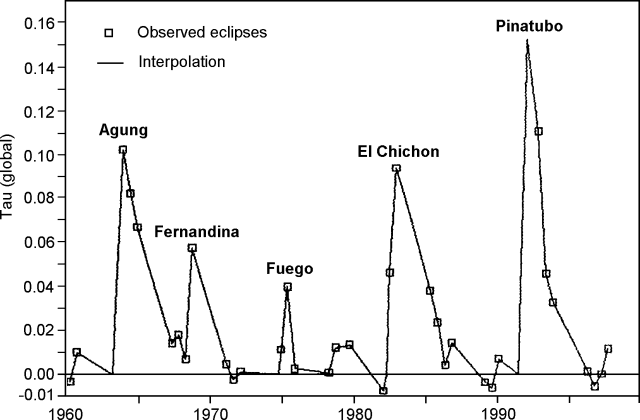Report on Atmospheric Effects (1995-2001) — November 1997

Atmospheric Effects (1995-2001)
Bulletin of the Global Volcanism Network, vol. 22, no. 11 (November 1997)
Managing Editor: Richard Wunderman.
Atmospheric Effects (1995-2001) Volcanic aerosol optical thicknesses since 1960
Please cite this report as:
Global Volcanism Program, 1997. Report on Atmospheric Effects (1995-2001) (Wunderman, R., ed.). Bulletin of the Global Volcanism Network, 22:11. Smithsonian Institution.
Atmospheric Effects (1995-2001)
All times are local (unless otherwise noted)
Richard A. Keen submitted the following report. About once per year, on average, the moon is eclipsed as it passes into the earth's shadow; at these times it can be used a remote sensor of the globally averaged optical depth of stratospheric aerosols of volcanic origin. Conceptually, the linkage between volcanic aerosols and lunar eclipses is as follows: 1) The moon is visible during total lunar eclipses due to sunlight refracted into the shadow (umbra) by the earth's atmosphere (primarily the stratosphere); 2) Stratospheric aerosols reduce the transmission of sunlight into the umbra; and 3) The path length of sunlight through a stratospheric aerosol layer is ~40x the vertical thickness of the layer. Therefore, the brightness of the eclipsed moon is extremely sensitive to the amount of aerosols in the stratosphere.
Methodology and data reduction. Aerosol optical thicknesses can be calculated for the date of an eclipse from the difference between the observed brightness of the eclipse and a modeled brightness computed for an aerosol-free standard atmosphere, modified by assumed distributions of ozone and cloud. A report on this technique, applied to observations during 1960 through 1982, appeared in Keen (1983); an update following the eruption of Pinatubo was reported in February 1993 (Bulletin v. 18, no. 2).
This report updates the time series from 1960 through the lunar eclipse of 16 September 1997 (figure 4), the last total lunar eclipse until January 2001. Plotted values are actual derived optical depths, modified as described below. Due to the higher concentration of Agung and El Chichón aerosols in the southern and northern hemispheres, respectively, a sampling bias due to the moon's passing though the southern or northern portion of the umbra was removed by using an empirical adjustment factor of 0.8 (thus, if the moon passed south of the earth's shadow axis during an eclipse following Agung, the derived optical thickness was multiplied by 0.8, while the derived value was divided by 0.8 if the moon passed north of the axis).
 |
Figure 4. Volcanic aerosol optical thicknesses derived from 35 total or near-total lunar eclipses during 1960-97. Courtesy of Richard Keen. |
No lunar eclipses occurred until 18 months after the June 1991 Pinatubo eruption, while results from Agung and El Chichón indicate that peak optical depths occurred about 9 months after those eruptions. Therefore, for plotting purposes, the time series of optical thicknesses following Pinatubo was extrapolated backwards to a date 9 months after the eruption using a composite decay curve derived from the Agung and El Chichón data. Finally, the global optical depths were set to zero on the dates of the eruptions of Agung, Fuego, and Pinatubo; observed values were near zero for eclipses close to the eruption dates of Fernandina and El Chichón.
Time series. The volcanic eruptions probably responsible for the major peaks in the time series are identified, although the correlation of Fernandina with the 1968 peak is highly uncertain. Comparative maximum global optical thicknesses are: Pinatubo (1991), 0.15; Agung (1963), 0.10; El Chichón (1982), 0.09; Fernandina (1968), 0.06; Fuego (1974), 0.04. The results indicate that the volcanic aerosol veil from Pinatubo disappeared between the eclipses of November 1993 and April 1996, with optical depth probably reaching zero sometime in 1995. A slight increase to an observed value of 0.01 for the September 1997 eclipse is close to the noise level due to the uncertainty in the brightness observations; if real, it could indicate aerosols from the eruption of Soufriere Hills. Interestingly, a similarly slight increase in optical depth in 1979 may have been due to the eruption of Soufriere of St. Vincent.
Acknowledgments. Thanks are due to the following who supplied observations of the four eclipses in 1996-97: K. Hornoch and M. Plsek (Czech Republic), G. Glitscher (Germany), K. Yoshimoto (Japan), K. Al-Tell, N. Abanda, M. Odeh, S. Abdo (Jordan), R. Bouma, G. Comello, H. Feijth, and E. van Dijk (Netherlands), B. Granslo and O. Skilbrei (Norway), C. Vitorino and A. Pereira (Portugal), P. Schlyter (Sweden), R. Pickard, A. Moss, J. Shanklin, and W. Worraker (UK), and D. Green (USA).
Reference. Keen, R., 1983, Volcanic aerosols and lunar eclipses: Science, v. 222, p. 1011- 1013.
Information Contacts: Richard A. Keen, 34296 Gap Road, Golden, CO 80403 USA.
